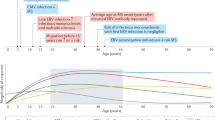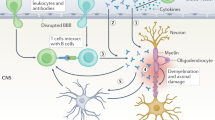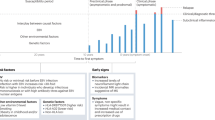Abstract
One hypothesis that couples infection with autoimmune disease is molecular mimicry. Molecular mimicry is characterized by an immune response to an environmental agent that cross-reacts with a host antigen, resulting in disease1,2. This hypothesis has been implicated in the pathogenesis of diabetes, lupus and multiple sclerosis (MS)1,2,3,4. There is limited direct evidence linking causative agents with pathogenic immune reactions in these diseases. Our study establishes a clear link between viral infection, autoimmunity and neurological disease in humans. As a model for molecular mimicry, we studied patients with human T-lymphotropic virus type 1 (HTLV-1)-associated myelopathy/tropical spastic paraparesis (HAM/TSP), a disease that can be indistinguishable from MS (refs. 5,6,7). HAM/TSP patients develop antibodies to neurons8. We hypothesized these antibodies would identify a central nervous system (CNS) autoantigen. Immunoglobulin G isolated from HAM/TSP patients identified heterogeneous nuclear ribonuclear protein-A1 (hnRNP-A1) as the autoantigen. Antibodies to hnRNP-A1 cross-reacted with HTLV-1-tax, the immune response to which is associated with HAM/TSP (refs. 5,9). Immunoglobulin G specifically stained human Betz cells, whose axons are preferentially damaged7. Infusion of autoantibodies in brain sections inhibited neuronal firing, indicative of their pathogenic nature. These data demonstrate the importance of molecular mimicry between an infecting agent and hnRNP-A1 in autoimmune disease of the CNS.
This is a preview of subscription content, access via your institution
Access options
Subscribe to this journal
Receive 12 print issues and online access
$209.00 per year
only $17.42 per issue
Buy this article
- Purchase on Springer Link
- Instant access to full article PDF
Prices may be subject to local taxes which are calculated during checkout



Similar content being viewed by others
References
Oldstone, M. Molecular mimicry and immune mediated disease. FASEB J. 12, 1255–1265 (1998).
Albert, L.J. & Inman, R.D. Molecular mimicry and autoimmunity. New Engl. J. Med. 341, 2068–2074 (1999).
Gran, B., Hemmer, B., Vergelli, M., McFarland, H. & Martin, R. Molecular mimicry and multiple sclerosis: Degenerate T-cell recognition and the induction of autoimmunity. Ann. Neurol. 45, 559–567 (1999).
Fujinami, R. & Oldstone, M. Amino acid homology between the encephalitogenic site of myelin basic protein and virus: A mechanism for autoimmunity. Science 230, 1043–1045 (1985).
Jacobson, S., Shida, H., McFarlin, D., Fauci, A. & Koenig, S. Circulating CD8+ cytotoxic lymphocytes specific for HTLV-1 in patients with HTLV-1 associated neurological disease. Nature 348, 245–248 (1990).
Levin, M. et al. Immunopathogenesis of HTLV-1 associated neurologic disease based on a spinal cord biopsy from a patient with HTLV-1 associated myelopathy/tropical spastic paraparesis (HAM/TSP). New. Engl. J. Med. 336, 839–845 (1997).
Levin, M. & Jacobson, S. HTLV-I associated myelopathy/tropical spastic paraparesis (HAM/TSP): A chronic progressive neurologic disease associated with immunlogically mediated damage to the central nervous system. J. Neurovirol. 3, 126–140 (1997).
Levin, M. et al. Neuronal molecular mimicry in immune mediated neurologic disease. Ann. Neurol. 44, 87–98 (1998).
Lal, R., Giam, C., Coligan, J. & Rudolph, D. Differential immune responsiveness to the immunodominant epitopes of regulatory proteins (tax and rex) in human T-cell lymphotropic virus type I associated myelopathy. J. Infect. Dis. 169, 496–503 (1994).
Kahn, R., Bertorini, T. & Levin, M. Neurologic complications of HTLV-1 infection. The Neurologist 7, 271–278 (2001).
Beranova-Giorgianni, S. & Desiderio, D. Mass spectrometry of the human pituitary proteome: Identification of selected proteins. Rapid Commun. Mass Spectrom. 14, 161–167 (2000).
Biamonti, G., Ghigna, C., Caporali, R. & Montecucco, C. Heterogeneous nuclear ribonucleoproteins (hnRNPs): An emerging family of autoantigens in rheumatic diseases. Clin. Exp. Rheumatol. 16, 317–326 (1998).
Krecic, A.M. & Swanson, M.S. hnRNP complexes: Composition, structure, and function. Curr. Opin. Cell Biol. 11, 363–371 (1999).
Nakielny, S. & Dreyfuss, G. Nuclear export of proteins and RNAs. Curr. Opin. Cell Biol. 9, 420–429 (1997).
Shyu, A.-B. & Wilkinson, M.F. The double lives of shuttling mRNA binding proteins. Cell 102, 135–138 (2000).
Kamma, H., Portman, D.S. & Dreyfuss, G. Cell type-specific expression of hnRNP proteins. Exp. Cell Res. 221, 187–196 (1995).
Lassek, A.M. The human pyramidal tract. IV. A study of the mature, myelinated fibers of the pyramid. J. Comp. Neurol. 76, 217–225 (1942).
Callaway, J., Lasser-Ross, N., Stuart, N. & Ross, W. Dynamics of intracellular free calcium concentration in the presynaptic arbors of individual barnacle photoreceptors. J. Neurosci. 13, 1157–1166 (1993).
Nagai, M. et al. Analysis of HTLV-1 proviral load in 202 HAM/TSP patients and 243 asymptomatic HTLV-1 carriers: High proviral load strongly predisposes to HAM/TSP. J. Neurovirol 4, 586–593 (1998).
Muller, S. et al. IgG Autoantibody response in HTLV-1-infected patients. Clin. Immunol. Immunopathol. 77, 282–290 (1995).
Warren, K., Catz, I. & Steinman, L. Fine specificity of the antibody response to myelin basic protein in the central nervous system in multiple sclerosis: The minimal B-cell epitope and a model of its features. Proc. Natl. Acad. Sci. USA 92, 11061–11065 (1995).
Romero, I. et al. Interactions between brain endothelial cells and human T-cell leukemia virus type 1 infected lymphocytes: Mechanisms of viral entry into the central nervous system. J. Virol. 74, 6021–6030 (2000).
Giraudon, P. et al. T lymphocytes activated by persistent viral infection differentially modify the expression of metalloproteinases and their endogenous inhibitors, TIMPs, in human astrocytes: Relevance of HTLV-I-induced neurologic disease. J. Immunol. 164, 2718–2727 (2000).
Chen, W., Elias, R.V., Cao, W., Lerious, V. & McGinnis, J.F. Anti-recoverin antibodies cause the apoptotic death of mammalian photoreceptor cells in vitro. J. Neurosci. Res. 57, 706–718 (1999).
Munro, T.P. et al. Mutational analysis of a heterogeneous nuclear ribonucleoprotein A2 response element for RNA trafficking. J. Biol. Chem. 274, 34389–34395 (1999).
Acknowledgements
We thank K. Troughton, E. Umstot and J. Berk for technical assistance; C. Raine for autopsy material; S. Jacobson for some of the serum samples; and B. Langton for the HTLV-1-tax monoclonal antibody obtained through the AIDS Research and Reference Reagent Program, Division of AIDS, NIAID, NIH. This material is based upon work supported by the Office of Research and Development, Medical Research Service, Department of Veterans Affairs. This study was funded by the VA Career Development Award and NIH RO1-NS-38876 (to M.C.L.), and NIH RR 10522 and NSF-DBI-9604633 (to D.M.D.).
Author information
Authors and Affiliations
Corresponding author
Ethics declarations
Competing interests
The authors declare no competing financial interests.
Rights and permissions
About this article
Cite this article
Levin, M., Lee, S., Kalume, F. et al. Autoimmunity due to molecular mimicry as a cause of neurological disease. Nat Med 8, 509–513 (2002). https://doi.org/10.1038/nm0502-509
Received:
Accepted:
Issue Date:
DOI: https://doi.org/10.1038/nm0502-509
This article is cited by
-
Anti-N-methyl-D-aspartate receptor encephalitis associated with chronic myelogenous leukemia, causality or coincidence? A case report
BMC Neurology (2022)
-
The CXCL13/CXCR5-chemokine axis in neuroinflammation: evidence of CXCR5+CD4 T cell recruitment to CSF
Fluids and Barriers of the CNS (2021)
-
Neuronal impairment following chronic Toxoplasma gondii infection is aggravated by intestinal nematode challenge in an IFN-γ-dependent manner
Journal of Neuroinflammation (2019)
-
Immunovirological markers in HTLV-1-associated myelopathy/tropical spastic paraparesis (HAM/TSP)
Retrovirology (2019)
-
Localization Analysis of Heterophilic Antigen Epitopes of H1N1 Influenza Virus Hemagglutinin
Virologica Sinica (2019)



